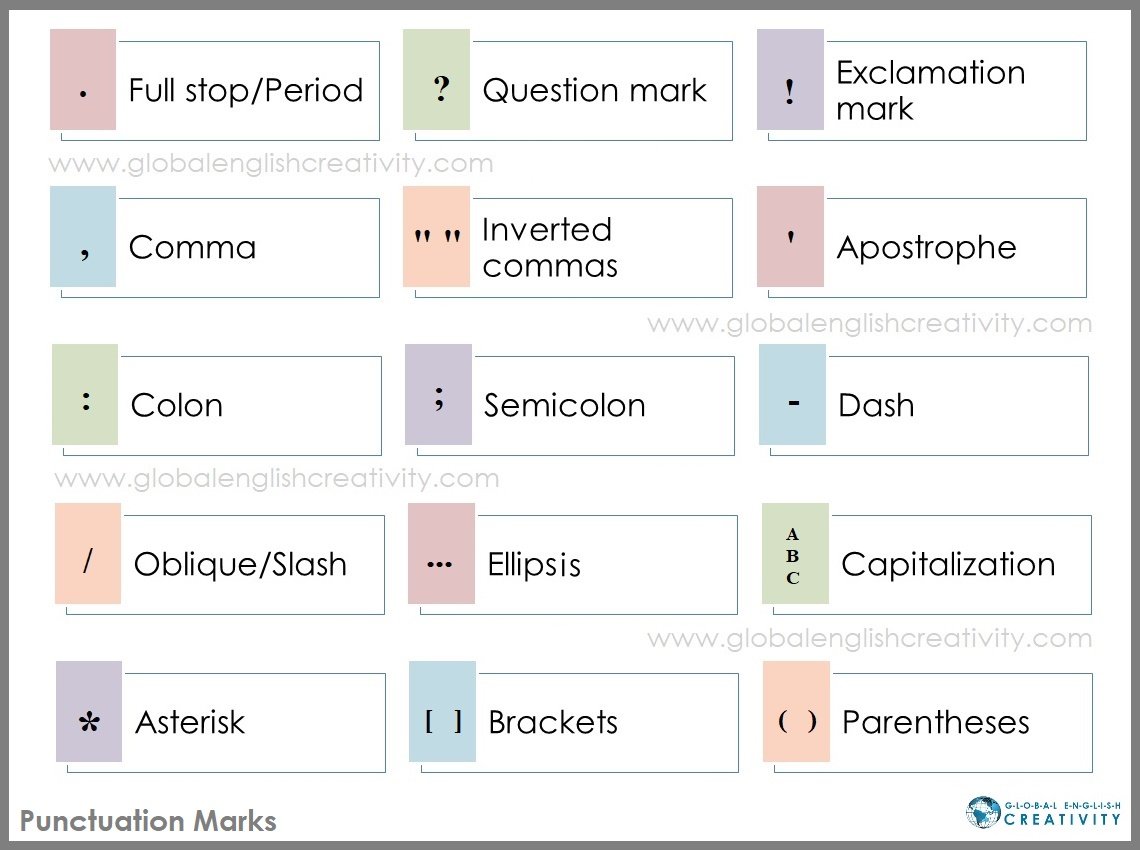| ‘Punctuation’ are marks or symbols, used to separate sentences, phrases and clauses. They not only help to decorate the sentence but also make the sentence grammatically correct.
Punctuation marks help to indicate pauses in certain situations. They focus on specific ideas and views in sentences, by conveying the exact meaning of the text. They help to create a sense of language. |
| FULL STOP/PERIOD |
The little dot which we find at the end of a sentence is called FULL STOP in British English and PERIOD in American English.
|

| QUESTION MARK |
|
|

| EXCLAMATION MARK |
|
|

| COMMA |
A COMMA is a symbol, used especially as a mark of separation within the sentence. It is the symbol, used to separate parts of a sentence showing a slight pause, or to separate items in a list.
|

| INVERTED COMMAS |
A INVERTED COMMA is a mark, used to attribute the enclosed text to someone else. It is skillfully used to show where Speech or a Quotation begins and ends. In American English, Inverted Commas are called Quotation Marks.
|

| APOSTROPHE |
APOSTROPHE is the punctuation mark which is used either to omit letters or to show possession.
|

| COLON |
COLON is the punctuation mark which is used before a list, quotation or explanation in a sentence.
|

| SEMICOLON |
SEMI-COLON is the punctuation mark which indicates a pause, typically between two main clauses.
|

| DASH |
|
|

| OBLIQUE/SLASH |
OBLIQUE/SLASH is a slanting bar used to represent exclusive or inclusive or, division and fractions, and as a date separator.
|

| ELLIPSIS |
Informally, ELLIPSIS is known as dot-dot-dot. This series of dots indicates an intentional omission of a word, sentence, or whole section from a text.
|

| CAPITALIZATION |
CAPITALIZATION means writing a word with its first letter as a capital letter/uppercase and the remaining letters in lower case/small letter.
|

| ASTERISK |
ASTERISK is a star-shaped punctuation mark, derived from the Greek word asteriskos which means ‘little star’. It is used to denote a footnote, to indicate an omission of letters in an abusive/taboo words, and to point to disclaimers. *There are literally hundreds of companies. |

| BRACKETS |
Generally, BRACKETS refer to square brackets. We usually use square brackets – [ ] – for special purposes such as in technical manuals, books, articles etc. Brackets are used for ‘extra information’, or information that is not part of the main content. Brackets are used to alter another person’s words. By using brackets, we make it clear that it’s we who changed the words, not the original author.
|

| PARENTHESES |
Generally, PARENTHESES refers to round brackets ( ). The use of round brackets – ( ) – is similar to commas. We add further explanation, an afterthought, or comment that is to do with our main line of thought, but different from it.
|

Grammar Topics_1
Grammar Topics_2
Useful Expressions in English Speaking
Grammar: Spot the Error









































Its very knowledgeable